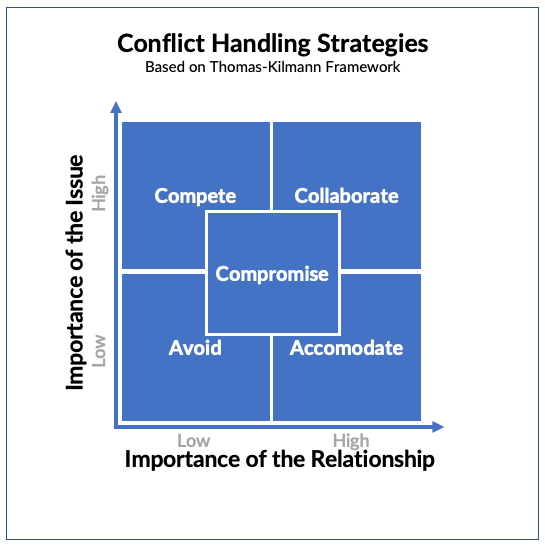The Biggest Mistake Leaders Make When Dealing With Conflict
The biggest mistake that people make when dealing with conflict is not giving themselves options.
We all have personality traits, behavioural styles and communication preferences that are deeply ingrained. These traits and preferences guide our action in a variety of situations, more so when we are emotionally aroused and relying primarily on System 1 Thinking (Fast Thinking). These default behaviours lead us to labelling ourselves - some people consider themselves conflict averse, whereas others feel moderate conflict brings out the best in them.
However, relying on your factory defaults in conflict situations is a mistake. This is not a good strategy because it locks you down to just one approach to conflict. This ignores the context (What/When/Where/Who) of the conflict situation, and prevents you from exploring other options which may offer better outcomes.
Also, if you are known to always behave in a particular way in the face of conflict, others can manipulate this pattern to your detriment. A classic example of this is bullying - bullies prey on people who don't like conflict. If you have a history of avoiding conflict and giving in, the bully will capitalize on this.
If responding to conflict in your default way is not desirable, what should you do? One of the more popular ways of answering this is the Thomas-Kilmann framework for handling conflict. The TK framework looks at conflict situations through two lenses - Issues and Relationships. Your response in a given conflict situation should be based on the relative importance of the Issue, and the Relationship with the people involved.

When both the issue and relationship are unimportant, avoidance is a perfectly legitimate strategy. Why spend time engaging when you don’t value the outcome, or have no desire to build a relationship. This is another way of saying don’t sweat the small stuff. And while I don’t believe “and it’s all small stuff”, I think there’s a lot of potential conflict situations that we can safely ignore.
When the issue is not very important for us personally, but we realise it is important to the other person, we can willingly give in. This strategic accommodation is different from avoidance - it still requires us to engage, and let the other person know we are letting go for their sake. Accommodation is useful in building or improving your relationship with the other person. In other words, they owe you one.
When the issue is very important, and the relationship is less so, the recommended strategy is competition - fight for the outcomes you desire, and defend your position on the issue. This can also be characterised as a win/lose approach - in competition, there can only be one winner. While some people use this approach indiscriminately, this is best practised in moderation - when the issue is of critical importance, and lack of time makes taking others along extremely difficult. Done correctly, this is the equivalent of fighting for the greater good.
When the issue is important, but you also value the relationship highly, the appropriate TK conflict handling style would be collaboration. While it is difficult to argue against the desirability of collaboration, it would not be wise to make this your go to strategy for all situations. Adopting a collaborative approach to every potential conflict situation will require you to invest significantly more time, effort and attention than you can probably afford to. In other words, it can be too much of a good thing.
Most 2 x 2 frameworks stop at four strategies. In this case, the creators of the framework, psychologists Kenneth Thomas and Ralph Kilmann, decided to throw in an extra bonus for when you can’t quite figure out what you value more, or more realistically, when the other strategies cannot be applied under the circumstances. This is the strategy of compromise. The compromise strategy is often described as lose-lose, because unlike the other strategies, neither of the parties to the conflict get quite what they want in a compromise. However, this might be a useful temporary strategy - while you create the space and circumstances for a more permanent resolution. You should be careful in using compromise as your default conflict management strategy - since it often throws up the equivalent of King Solomon’s choice.
Personally, while I quite like the idea of looking at every situation in fresh light and choosing an appropriate strategy, I think we also run the risk of being overly transactional. As leaders who wish to work better with and through others to create bigger impact, we need to give relationships their due. Which is to say, collaborate as much as you can, be large hearted and accommodate to build better relationships, compete selectively, avoid avoiding conflict unless you have to, and don’t compromise unless you are doing it to buy time.
The above is a fairly superficial look at the TK framework, which has more depth and nuance to guide your behaviour in conflict situations. For a more detailed look at the model, have a look at this very comprehensive overview by one of the creators, Dr Ralph Kilmann. For a more practical treatment and application of this and other useful models of managing conflict, consider attending one of my public workshops on Communication Skills.
What are some strategies that you have successfully used in dealing with conflict situations?
Please leave a comment below or send me an email, and I’ll do my best to answer your questions.
